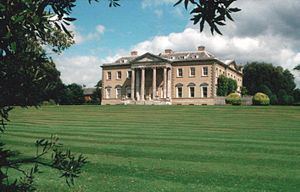 | ||
Similar King John's House, Romsey Abbey, Sir Harold Hillier Gardens, Paultons Park, Mottisfont Abbey | ||
The broadlands archives feature
Broadlands is an English country house, located in the civil parish of Romsey Extra, near the town of Romsey in the Test Valley district of Hampshire, England.
Contents
History
The original manor and area known as Broadlands has belonged to Romsey Abbey since before the time of the 11th-century English Norman Conquest.
After the Dissolution of the Monasteries, Broadlands was sold to Sir Francis Fleming in 1547. His granddaughter married Edward St. Barbe, and the manor remained the property of the St. Barbe family for the next 117 years. Sir John St Barbe, 1st Baronet (c. 1655–1723) made many improvements to the manor but died without progeny having bequeathed it to his cousin Humphrey Sydenham of Combe, Dulverton. In the chancel of Ashington Church, Somerset, is a monument of grey and white marble, inscribed:
Here lies Sir John St. Barbe, Bart. possessed of those amiable qualities, which birth, education, travel, greatness of spirit, and goodness of heart, produce. Interred in the fame vault lies his second wife Alice Fiennes, aunt to the prefent Lord Say and Sele. His first was Honour, daughter of Colonel Norton. He died at his seat of Broadlands in Hampshire Sept. 7, 1723, leaving for his only heir and executor Humphrey Sydenham, esq., of Combe in Somerfetshire, who ordered this marble to his memory.
When Sydenham was ruined by the 18th-century South Sea Bubble, he proceeded to sell Broadlands to Henry Temple, 1st Viscount Palmerston in 1736. It was the latter who began the deformalisation of the gardens between the river and the house and produced the (broad-lands) the "gentle descent to the river".
In 1767, a major architectural "transformation" was begun by Capability Brown, the celebrated architect and landscape designer, and completed by architect Henry Holland, which led to making Broadlands the Palladian-style mansion seen today.
Henry Temple, 2nd Viscount Palmerston had requested that Brown go there and seize upon the "capabilities" of the earlier Tudor and Jacobean manor house. Between 1767 and 1780, William Kent's earlier "deformalising work" was completed, as well as further landscaping, planting, clearing and riverside work.
Broadlands was the country estate of the nineteenth century prime minister Henry John Temple, 3rd Viscount Palmerston.
Queen Elizabeth II (then Princess Elizabeth) and Prince Philip spent their honeymoon at Broadlands in November 1947; Earl Mountbatten, whose home Broadlands was at the time, was Philip's uncle. In 1981, the newly married Prince and Princess of Wales also spent the first three days of their honeymoon at Broadlands, travelling to the estate by train from London Waterloo.
In current times
Broadlands is occupied by Lord and Lady Brabourne (who until 2005 enjoyed the courtesy style of Lord and Lady Romsey, a subsidiary title of Patricia Knatchbull, 2nd Countess Mountbatten of Burma, Lord Brabourne's mother, whose late husband was John Knatchbull, 7th Baron Brabourne).
Norton Knatchbull, 8th Baron Brabourne is the grandson of Louis Mountbatten, 1st Earl Mountbatten of Burma. Should the title pass from the 2nd Countess Mountbatten on death to her son, the seat of the earldom would again be Broadlands as it was in Earl Mountbatten's time.
